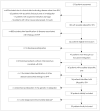Idiopathic small fiber neuropathy: phenotype, etiologies, and the search for fabry disease
- PMID: 24829596
- PMCID: PMC4017013
- DOI: 10.3988/jcn.2014.10.2.108
Idiopathic small fiber neuropathy: phenotype, etiologies, and the search for fabry disease
Abstract
Background and purpose: The etiology of small fiber neuropathy (SFN) often remains unclear. Since SFN may be the only symptom of late-onset Fabry disease, it may be underdiagnosed in patients with idiopathic polyneuropathy. We aimed to uncover the etiological causes of seemingly idiopathic SFN by applying a focused investigatory procedure, to describe the clinical phenotype of true idiopathic SFN, and to elucidate the possible prevalence of late-onset Fabry disease in these patients.
Methods: Forty-seven adults younger than 60 years with seemingly idiopathic pure or predominantly small fiber sensory neuropathy underwent a standardized focused etiological and clinical investigation. The patients deemed to have true idiopathic SFN underwent genetic analysis of the alpha-galactosidase A gene (GLA) that encodes the enzyme alpha-galactosidase A (Fabry disease).
Results: The following etiologies were identified in 12 patients: impaired glucose tolerance (58.3%), diabetes mellitus (16.6%), alcohol abuse (8.3%), mitochondrial disease (8.3%), and hereditary neuropathy (8.3%). Genetic alterations of unknown clinical significance in GLA were detected in 6 of the 29 patients with true idiopathic SFN, but this rate did not differ significantly from that in healthy controls (n=203). None of the patients with genetic alterations in GLA had significant biochemical abnormalities simultaneously in blood, urine, and skin tissue.
Conclusions: A focused investigation may aid in uncovering further etiological factors in patients with seemingly idiopathic SFN, such as impaired glucose tolerance. However, idiopathic SFN in young to middle-aged Swedish patients does not seem to be due to late-onset Fabry disease.
Keywords: Fabry disease; etiology; idiopathic; impaired glucose tolerance; small fiber neuropathy.
Conflict of interest statement
The authors have no financial conflicts of interest.
Figures

Similar articles
-
Screening for Fabry disease and Hereditary ATTR amyloidosis in idiopathic small-fiber and mixed neuropathy.Muscle Nerve. 2019 Mar;59(3):354-357. doi: 10.1002/mus.26348. Epub 2018 Dec 4. Muscle Nerve. 2019. PMID: 30246259
-
Small Fiber Neuropathy Incidence, Prevalence, Longitudinal Impairments, and Disability.Neurology. 2021 Nov 30;97(22):e2236-e2247. doi: 10.1212/WNL.0000000000012894. Epub 2021 Oct 27. Neurology. 2021. PMID: 34706972 Free PMC article.
-
Frequency of Fabry disease in patients with small-fibre neuropathy of unknown aetiology: a pilot study.Eur J Neurol. 2011 Apr;18(4):631-6. doi: 10.1111/j.1468-1331.2010.03227.x. Epub 2010 Sep 23. Eur J Neurol. 2011. PMID: 20860754
-
Small-Fiber Neuropathy: An Etiology-Oriented Review.Brain Sci. 2025 Feb 6;15(2):158. doi: 10.3390/brainsci15020158. Brain Sci. 2025. PMID: 40002491 Free PMC article. Review.
-
Small fiber neuropathies: expanding their etiologies.Curr Opin Neurol. 2022 Oct 1;35(5):545-552. doi: 10.1097/WCO.0000000000001103. Epub 2022 Aug 11. Curr Opin Neurol. 2022. PMID: 35950732 Review.
Cited by
-
Idiopathic distal sensory polyneuropathy: ACTTION diagnostic criteria.Neurology. 2020 Dec 1;95(22):1005-1014. doi: 10.1212/WNL.0000000000010988. Epub 2020 Oct 14. Neurology. 2020. PMID: 33055271 Free PMC article. Review.
-
A Case of Autoimmune Small Fiber Neuropathy as Possible Post COVID Sequelae.Int J Environ Res Public Health. 2023 Mar 10;20(6):4918. doi: 10.3390/ijerph20064918. Int J Environ Res Public Health. 2023. PMID: 36981826 Free PMC article.
-
Recurrent fever of unknown origin: An overlooked symptom of Fabry disease.Mol Genet Genomic Med. 2020 Oct;8(10):e1454. doi: 10.1002/mgg3.1454. Epub 2020 Aug 14. Mol Genet Genomic Med. 2020. PMID: 32797665 Free PMC article.
-
Small Fiber Neuropathy in Burning Mouth Syndrome: A Systematic Review.Int J Mol Sci. 2024 Oct 24;25(21):11442. doi: 10.3390/ijms252111442. Int J Mol Sci. 2024. PMID: 39518993 Free PMC article.
-
No Fabry Disease in Patients Presenting with Isolated Small Fiber Neuropathy.PLoS One. 2016 Feb 11;11(2):e0148316. doi: 10.1371/journal.pone.0148316. eCollection 2016. PLoS One. 2016. PMID: 26866599 Free PMC article.
References
-
- Lacomis D. Small-fiber neuropathy. Muscle Nerve. 2002;26:173–188. - PubMed
-
- Novak V, Freimer ML, Kissel JT, Sahenk Z, Periquet IM, Nash SM, et al. Autonomic impairment in painful neuropathy. Neurology. 2001;56:861–868. - PubMed
-
- Bednarik J, Vlckova-Moravcova E, Bursova S, Belobradkova J, Dusek L, Sommer C. Etiology of small-fiber neuropathy. J Peripher Nerv Syst. 2009;14:177–183. - PubMed
-
- Singleton JR, Smith AG, Bromberg MB. Painful sensory polyneuropathy associated with impaired glucose tolerance. Muscle Nerve. 2001;24:1225–1228. - PubMed
LinkOut - more resources
Full Text Sources
Other Literature Sources
Research Materials
Miscellaneous

